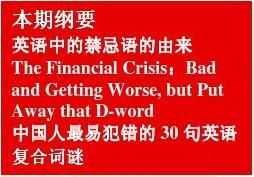英语学习资料及资源推荐
天籁之英英语协会
学习资源
20xx年12月4

日
1.听力方面
? 《英语听力入门》(step by step),华东师范大学出版社,张民伦 ? 《英语初级听力》(Listen to This 1),外语教学与研究出版社,何其莘
? 《英语中级听力》(Listen to This 2),外语教学与研究出版社,何其莘
? 《英语高级听力》(Listen to This 3),外语教学与研究出版社,何其莘
? 美国之音VOA:
? 英国广播公司BBC:www.bbc.co.uk
? 美国国家公共电台NPR:
2.阅读方面
? 《书虫》,外语教学与研究出版社
? 《新概念英语》,外语教学与研究出版社
? 《纽约时报》(The New York Times): ? 《新闻周刊》(Newsweek):
? 《经济学家》(The Economist):
? 美国有线电视新闻网CNN:
3.口语方面:
? 《美国英语语音语调速成》,西安交通大学出版社
4.翻译方面
? 《英汉翻译简明教程》,外语教学与研究出版社,庄绎传 ? 《中式英语之鉴》,外语教学与研究出版社,平卡姆 ? 《英语文摘》(English Digest),英语沙龙杂志社
? 爱思英语网“双语人文专栏”:
5.新托福考试(TOEFLIBT)
? 《ETS新托福考试官网指南》,北京语言大学出版社
? 《新托福考试备考策略与模拟试题》(Delta),群言出版社 ? 《新托福考试综合教程》(Longman),群言出版社
? 《新托福考试全真模考题与精解》(巴朗),群言出版社
6.GRE:
? 单词
? 《GRE词汇精选》(红宝书),群言出版社,俞敏洪 ? 《GRE词汇逆序记忆小词典》,群言出版社,俞敏洪 ? 《17天搞定GRE单词》,西安交通大学出版社,杨鹏 ? 类反:《GRE类比/反义词》,西安交通大学出版社,宋昊 ? 填空:《GRE句子填空》,西安交通大学出版社,陈圣元 ? 阅读
? 《GRE阅读39+3全攻略》,清华大学出版社,魏宇燕
? 《GRE&GMAT阅读难句教程》,世界图书出版公司,杨鹏 ? 《GRE阅读剖析及全真题解读》,世界知识出版社,杨继 ? 数学
? 《GRE数学高分快速突破》,西安交通大学出版社,陈向东
? 写作
? 《GRE官方题库范文精讲》西安交通大学出版社,斯图尔特 ? 《GRE写作》,西安交通大学出版社,孙远
? 《GRE作文大讲堂—方法、素材、题目剖析》群言出版社,韦晓亮
7.网络学习资源:
? 爱思英语网:
? 普特英语听力:
? 沪江英语:
? 旺旺英语学习网:
? 寄托天下:
? 太傻网:
? ChaseDream论坛:
8.看电影学英语:
? 太傻网:
? 可可英语:
? 爱酷英语:
9.在线词典资源:
? 字典:
? 字典兼百科全书:
? 俚语口语词典:
? 缩写词词典:
? 多功能词典:
第二篇:英语学习资料(第一期)

分 享 THE SHARER
SIPC&ICCT 2009.03(第一期) 第一期)

We learn We share 趣味课堂 危险英语一 危险英语一 英语中的禁忌语的由来 英语中的禁忌语的由来
对于有些英语词汇,父母、教师、宗教人士以及教义书籍都会告诫年轻人不要随便说出口。这种“词汇审查制度”避免了危险词汇可能在公共场合给人带来的紧张。人们选择发明新词来代替那些不雅的、说不出口的词,可有些时候这些新词最后也会变成禁忌语。
美国社会在20世纪最后30年中发生了很多的变化,现在,很多禁忌词眼通常能够被接受,无论是出现在社团中、女性中还是媒体上,而在以前是绝对不可能耳闻的。但是在以下场合依旧不欢迎危险词汇:教会学校、祈祷堂、办公室、正式会议、混合了不同年龄层次和性别的聚会、在有老年人和小孩子的地方。 Reinhold Aman博士是“坏词”(maledicta)方面的研究专家。他认为,禁忌词汇可以分三类:淫秽下 流的(obscenities);亵渎上帝的(blashpemies);诽谤诋毁的(slurs)。 OBSCENTITIES是一些哪些话题是禁忌的?些话题是禁忌的? 粗鄙的词汇,涉及:人体的 性部位、性行为、排泄行为。 除了医务所之外,美国不过,在几世纪前,这些词人不在正式场合谈论的话例如cock(JB,其实中文中题包括: 把JB全拼出来也比较禁 与人体的性器官或性忌),fuck(操),shit(屎)行为有关的 曾可以自由使用。 与排泄等卫生间内的 事务有关的 BLASPHEMIES是宗教训 呕吐或者挖鼻屎之类导们所认为的禁忌,包括恶心的事情 God damn it;go to Hell; 癌症或者死亡之类令Jesus Christ!这些词允许人沮丧的事情 出现在宗教文书中,但仅此美国人也尽量避免讨而已。 论宗教、政治和种族事件, 以防止可能引发的观点冲 SLURS是指对他人的国突。(当然了,很多的情景籍、种族带有侮辱性的词剧因为元素的需要,往往刻眼,像kike(犹太佬),wop意制造这些冲突。) (移居美国的南欧人,尤其 是意大利人),nigger(黑哪些词眼是禁忌的?哪些词眼是禁忌的? 鬼)都名列于最最危险词汇 的榜单上。
为什么以上这些话题和词眼是禁忌?和词眼是禁忌?
禁忌有由来(某些禁忌,也有被解除的一天)。在历史的某个阶段,某一群体宣布某个词汇或者话题当成为禁忌。如果这个群体在社会上足够有影响力的话,那么这个禁忌由此而成。
美洲的英语社会于17世纪初开始形成。来自英格兰的清教徒为寻找信仰自由,乘着五月花移民至美洲。他们对性方面的戒律甚是严格:性是为了生育孩子,出于其他目的的性行为都是罪,是对上帝的猥亵。教会还训导众人,任何可能让人们想到性的东西(不仅仅是语言)不应当被暴露于阳光之下,被看到或者听到。于是,与肉体行为相关的词眼也因此成了禁忌。
到如今,4个世纪过去了,但是美国人依旧受这段早期历史的影响。大体上可以这么说:当话题涉及到裸体、性以及排泄行为等令他们感到尴尬的事物时,美国人就变得非常清教徒式。
作为基督教的至上之书,《圣经》中有部分思想是基于犹太教经文的。它训导众人,上帝不许人随便呼God,否则就是对神不敬,
犯了亵渎神灵的罪。这就是BLASPHEME的由来。
美国历史在很长一段时间内种族关系非常恶劣。从1619至1863年,很多(主要是美国南方)白人土地主把非洲黑人当做奴隶驱使,直到南北战争之后,黑人才得以解放,有了自由之身。而在之后的一百年,黑人并没有获得公民权,包括所在州的投票权。
同一时期,北美土著居民印第安人在与美国政府的争斗中屡屡失败,加上疾病和饥荒,人口不断减少。
尽管在今日的美国,种族关系得到了改善,但是诸多旧痛并未被遗忘,疑虑感和厌恶感在某些领域依旧存在。某一族群对另一族群的称呼往往带有贬低冒犯之意。很多具有良知的人士视之为禁忌,知道这些词眼会伤害他人。在白人中,NIGGER可能是美国英语中最具有禁忌色彩的一个词了。
不同种族的移民群体往往由于语言障碍而不能相互之间很好地沟通,往往一个种族群体对另一个种族群体的称谓就不是那么地尊重。
除了种族问题之外,还有以下这些弱势或者非主流的人群也往往难以获得法定权利或社会地位:女性、同性恋、残障人士、身相劣等(如猪八戒)、儿童、老年人、肥胖者、身高不具优势者、穷人。对这些人的称呼往往是带有贬义色彩的。
禁忌词汇的作用是什么?
禁忌词汇有着它的神奇力量。叛逆的青春期孩子用禁忌词汇来摆酷或破坏规矩;大声喊出一两个禁忌词汇有助于人释放压力,缓解痛苦;男人之间用禁忌的社交词汇来增进哥们感情;情侣之间使用禁忌的性事词汇来激发快感;而情景喜剧的演员们使用各种各样的禁忌语来达到搞笑的目的。
为什么会有那么多的词汇用来指称性和其他禁忌物呢?
禁忌语其实很有意思。人们也会花大量时间思考和讨论与禁忌有关的话题。在许多时候,人们用委婉语(euphemisms)或是平和的(off-color,slightly smutty)俚语来代替禁忌词汇。所以,尽管英语的普通词汇中说肩膀(shoulder)、
耳朵(ear)和膝盖(knee)都分别只有一个词,但是当涉及到人体的性部位时,却有上百个的词汇。
比如,Buttocks、behind、ass都是指代身体的同一个部位。Buttocks(臀部)在正式场合使用,是个“干净的词汇”,behind(后部)更加“干净”,基本在大场合也适用。而ass(屁股)就是个脏词(dirty word)了,在非正式场合用得很普遍。
又比如关于penis就有很多的别称,dick是其中之一。但同时,Dick也是一个非常普遍的男子名,就像Bill是William的昵称一样,Dick是Richard的昵称。在一个重视礼节的场合,我们可以讨论Dick这个人,但当dick指的是“家伙”的时候,就没那个门面拿出来讨论了。
不管怎么说,危险英语真的很危险,因为使用污蔑性的、致怒性的下流语言而遭致杀害并非不曾发生过,所以学好危险英语很重要!
(下一章:下一章:你的发音危险吗?) ?)
焦点阅读焦点阅读
The Financial Crisis
Bad and Getting
Worse, but Put Away that D-word
It began as the "subprime crisis" in 2007, and then mushroomed into a
full-blown global recession in 2008. And still, despite mammoth government intervention, the bad news keeps getting worse. Are we now teetering on a precipice, ready to plunge into another Great Depression? Can the latest proposals pull the
economy out of its nosedive? There is plenty to worry about. But while many experts say this crisis is the worst since the Depression, that does not mean it will be as bad.
Unemployment and other economic gauges will continue to worsen, but unless governments make a major misstep, like igniting a worldwide trade war,
economies should stabilize and recover on a "very flat path" that could take several years, says Wharton finance professor Marshall E. Blume. Japan went through a similar bank crisis in the 1990s without tumbling into a full-blown depression, adds Wharton finance professor
Jeremy J. Siegel. "Given that we're reacting faster than Japan, I think you can make a good inference that [a depression is] not going to happen here," he says. Many estimates call for gross domestic product in the U.S. to shrink by 2.6% in the first quarter of 2009, Siegel notes. That's bad, but small
compared to the 27% decline from 1929 through 1933. A depression is generally defined as a drop of 10% or more.
Still, there is more bad news than good, and the depth of the problem can be measured by the lack of consensus on what to do about it. Consider this gloomy observation in a January 20
Wall Street Journal story about the British
government's abrupt decision to pump billions more into what the writer called the country's "flagging" financial-rescue plan:
"Governments on both sides of the Atlantic are struggling to keep up with the
deepening economic crisis -- and may be running out of ammunition to battle it." In the U.S., banks continue to withhold loans despite huge infusions of government cash, and Goldman Sachs estimates that financial
institutions will lose $2 trillion on loans, with only half of that realized to date. Banks are even starting to call in loans to borrowers, such as home builders, who have made all their debt payments on time. Troubles are now expanding to
commercial real estate firms. The numbers of layoffs, bankruptcies and
foreclosures are growing. Household names, such as Circuit City electronics
stores, are closing their doors, and problems have worsened at Citigroup and Bank of America despite government help.
There is little consensus on how to remedy the problem. Indeed, the U.S. government is again considering buying up toxic assets held by financial firms, a plan adopted last fall and then immediately scrapped in favor of direct cash infusions to banks.
The tale of woe and
confusion is much the same around the world. The economic slowdown is so steep as to cause oil prices to drop to around $40 a barrel, from more than $140 last summer. Trade is so sluggish that shipping rates have plunged to astonishing lows. The European Commission warned on January 20 that the 27 nations of the
European Union are likely to experience a "deep and protracted recession." At the request of then President-elect Barack Obama, the Senate on
January 15 voted to release the second half of the $700 billion Troubled Asset Relief Program. (No action by the House is required.)
Comments from Obama administration officials suggest much of this $350 billion may be used to buy "bad assets" held by financial institutions. Those include mortgage-backed securities and other holdings that have plunged in value and become all but untradeable. Getting these assets off the financial institutions' books was at the heart of the TARP program when it was proposed in September by Treasury
Secretary Henry Paulson and Federal Reserve chairman Ben Bernanke.
Paulson and Bernanke say that removing the toxic assets would remove uncertainty about the banks' health, and encourage the banks to resume lending, seen as the key to turning the financial crisis around. But after Congress approved TARP, Paulson instead pumped the money directly into troubled banks, taking some preferred shares and warrants in
exchange, arguing the banks
needed quicker help because they had turned out to be in worse shape than previously thought. But the banks
remain reluctant to lend, and it is not clear the first half of the TARP fund was the good investment Paulson said it was. The Congressional Budget Office estimated in a January 16 report that taxpayers would lose $64 billion of the first $247 billion in TARP spending. Whether the government should now revive the
asset-purchase plan is subject to debate.
Wharton finance professor Richard Marston thinks the direct infusions will restore banks' lending ability faster than asset purchases would, but the government should in return demand a bigger ownership stake than it has. "The Treasury should find a way to inject capital where the taxpayer ends up with large stakes in the banks -- even if they are not formally nationalized. The bank shares are going to soar with recovery, and someone is going to make a fortune." That should be taxpayers if they take on the cost and risk of propping up the banks, Marston argues.
According to Blume, there is so much uncertainty that it is impossible to know which
bank-rescue approach is best. Cash infusions can help very quickly, while the asset
purchases take longer. But if direct infusions mean toxic assets are left on the banks' books, doubts about the banks' long-term health will remain. Other institutions would then be reluctant to do business with them, and investors would refuse to provide private capital,
which ultimately is key to the banks' return to health. Building a 'Bad Bank' Also under discussion in Washington is the creation of a "bad bank" to buy the toxic assets. This government-run bank, partly owned by the banks that sell it the assets, would hold those assets, sell them or bundle them into
securities for sale to investors. A big question: What should the bad bank pay for those assets if there are no recent sales to show what they are worth? FDIC chairman Sheila C. Bair has said the assets could be purchased at "fair value," which is a price the banks set themselves. "The idea of setting up a 'bad bank' in which to transfer bad debt may be a good idea," Marston says. But he finds the price dilemma troubling, since paying fair value could cause the government to pay more than it will eventually
recover by reselling the assets. "Do we pay market prices for the debt, in which case it does not help the banks? Do we pay
above-market prices" and take shares of the banks in exchange?
Under yet another approach, modeled on that used for Citigroup and Bank of America, the government would provide
taxpayer-backed insurance against losses in toxic assets that stay on banks' books. But that, too, could leave the public shouldering the banks' losses. Wharton finance professor Franklin Allen argues that the best approach would be "temporary nationalization" of those banks that get public help. That would allow the
government to install its own managers, clearing out executives who have presided over so much trouble.
Controlling TARP "This injection of capital without any [government] control is just not working," says Allen, noting that the banks had not resumed
lending after the first TARP infusion. "This [second $350 billion in] TARP money is not going to be used well, and it's going to end up in a black hole. What keeps
happening is they give money and then the banks keep coming back for more." Siegel, too, feels that TARP support should have more strings attached, such as a requirement that banks not call in loans to borrowers who are solvent,
creditworthy and up to date on their payments. "I'm not optimistic about this [second half of the] TARP money. Clearly, the first half didn't seem to help."
Obama administration
officials also have said they want to use part of the new round of TARP funding -- perhaps as much as $100 billion -- to help homeowners avoid foreclosures.
Advocates say this is only fair, since huge sums have gone to rescue corporations, and many argue that
stemming foreclosures will help stop the freefall in home prices which has been a major cause of the banks' losses. Hence, attacking the foreclosure problem could lead to more lending by banks, giving the economy the fuel it needs to start growing again.
There are various ways to use government money to put a dent in foreclosures, from providing direct assistance to homeowners to insuring lenders against further losses

if they modify loan terms. It is not yet clear what approach the Obama administration favors. Nor is it a given that reducing the number of foreclosures will have much effect. Allen believes the economic problems are now so widespread that shoring up the housing sector would not help turn things around the way its advocates hope, so that public spending on foreclosures might be wasted. "I think the crisis has moved on from real estate," he says. Allen and Siegel note that some banks already have expanded programs to
renegotiate loan terms to help borrowers stay in their homes. Accepting reduced payments can be less costly for the lenders than foreclosure, especially if there are no buyers for foreclosed
properties. J.P. Morgan, for example, recently announced a vastly expanded plan to modify loans on its books as well as those among more than $1 trillion in loans sold to investors. Too Many Homes
"I think [foreclosures are] a very important problem, but I think it's being worked out by the private sector," Siegel says. The root problem, according to Siegel: There
are too many homes and too many were bought at inflated prices. "The price of homes has to fall. There's no way to stop that from happening." Blume, too, doubts the government can effectively stop the wave of foreclosures. With the economy worsening and unemployment rising, fewer and fewer people can afford the homes they have, and many potential buyers lured by bargain prices can't find banks to give them mortgages. "I have not yet seen a plan to help reduce foreclosures that gets to ... the problem ... that people bought houses they could not afford. If you reduce the interest rate a little bit, they still can't afford them." He concludes that there may be no alternative but to let the housing market adjust on its own. "Ultimately, all these houses will be off the market," Blume says. "Somebody will buy them and then the market will stabilize."
But there's no telling, he adds, how long that will take, or how far home prices will have to fall.(the Wharton School of the University of Pennsylvania)
英语小贴士 中国人最易犯错的30句英语 句英语
注意,以下每组的第一句的句子是错误的或者是不为Native Speaker采用的说法)
1. I very like it
I like it very much.
2. 这个价格对我挺合适的。
The price is very suitable for me. The price is right. Note:suitable(合适的、相配的)最常见的用法是以否定的形式出现在告示或通知上,如:下列节目儿童不宜。The following programmer is not
suitable for children在这组句子中用后面的说法会更合适。
3. 你是做什么工作的呢? What’s your job? Are you working at the moment?
Note:what’s your job这种说法难道也有毛病吗?是的。因为如果您的谈话对象刚刚失业,如此直接的问法会让对方有失面子,所以您要问:目前您是在上班吗?Are you working at the moment? 接下来您才问:目前您在哪儿工作呢?
Where are you working these days?或者您从事哪个行业呢?What line of work are you in?顺带说一下,回答这类问题时不妨说得具体一点,不要只是说经理或者秘书
4. 用英语怎么说? How to say?
How do you say this in English?
Note:How to say是在中国最为泛滥成灾的中国式英语之一,这决不是地道的英语说法。同样的句子有:请问这个词如何拼写?How do you spell that please?请问这个单词怎么读?How do you pronounce this word?
5. 明天我有事情要做。 I have something to do tomorrow?
Sorry but I am tied up all day tomorrow.
用I have something to do来表示您很忙,这也完全是中国式的说法。因为每时每刻我们都有事情要做,躺在那里睡大觉也是事情。所以您可以说我很忙,脱不开身:I’m tied up.还有其他的说法:I’m afraid I can’t make it at that time. I’d love to, but I can’t, I have to stay at home. 6. 我没有英文名。
I haven’t English name. I don’t have an English name.
Note:许多人讲英语犯这样的错误,从语法角度来分析,可能是语法功底欠缺,因为have在这里是实义动词,而并不是在现在完成时里面那个没有意义的助动词。所以,这句话由肯定句变成否定句要加助动词。
明白道理是一回事,习惯是另一回事,请您再说几话:我没有钱;I don’t have any money.我没有兄弟姐妹;I don’t have any brothers or sisters.我没有车。I don’t have a car.
7. 我想我不行。 I think I can’t. I don’t think I can. Note:这一组然是个习惯问题,在语法上称为否定前置,这就是汉语里面说“我想我不会”的时候,英语里面总是说“我不认为我会”。以后您在说类似的英语句子的时候,只要您留心,也会习惯英语的说法的,
8. 我的舞也跳得不好。 I don’t dance well too. I am not a very good dancer either.
Note:当我们说不擅长做什么事情的时候,英语里
面通常用not good at something,英语的思维甚至直接踊跃到:我不是一个好的舞者。
9. 现在几点钟了? What time is it now? What time is it, please? Note:What time is it now这是一个直接从汉语翻译过的句子,讲英语的时候没有必要说now,因为您不可能问what time was it yesterday, 或者what time is it tomorrow?所以符合英语习惯的说法是:请问现在几点了?还有一种说法是:How are we doing for time?这句话在有时间限制的时候特别合适
10. 我的英语很糟糕。 My English is poor.
I am not 100% fluent, but at least I am improving. Note:有人开玩笑说,全中国人最擅长的一句英文是:My English is poor.实话说,我从来没有遇到一个美国人对我说:My Chinese is poor. 无论他们的汉语是好是坏,他们会说: I am still having a few problem, but I getting better.
当您告诉外国人,您的英语很poor,so what(那又怎么样呢),是要让别人当场施舍给我们一些英语呢,
还是说我的英语不好,咱们不谈了吧。
另外一个更大的弊端是,一边不停的学英语,一边不停地说自己的英语很poor,这正像有个人一边给车胎充气,又一边在车胎上扎孔放气。
我坚信,先不谈别的,如果您现在就苦下功夫,把这本薄薄的《英语54321》吃通吃透,您的英语水平立即就会迅速的提高。所以您再也不用说:我的英语很poor. 您可以实事求事地说,我的英语还不算十分流利,但至少我在进步。
11. 你愿意参加我们的晚会吗? Would you like to join our party on Friday?
Would you like to come to our party on Friday night? Note:join往往是指参加俱乐部或者协会,如:join a health club; join the Communist Party.事实上,常常与party搭配的动词的come 或者go。如go a wild party,或者come to a Christmas Party。
12. 我没有经验。
I have no experience. I am afraid I don’t know much about that. Note:I have no experience这句话听起来古里古怪,因为您只需要说:那方面我懂得不多,或者这方面我不在行,就行了。I am not really an expert in this area.
13. 我没有男朋友。 I have no boyfriend. I don’t have a boyfriend.
14. 他的身体很健康。 His body is healthy. He is in good health. You can also say: He’s healthy.
15. 价钱很昂贵/便宜。 The price is too expensive/cheap.
The price is too high/ rather low.
16. 我们下了车。 We got off the car. We got out of the car.
17. 车速快了。
The speed of the car is fast.
The car is speeding. Or “The car is going too fast.”
18. 这个春节你回家吗? Will you be going back home for the Spring Festival?
是的,我回去。Of course! (这一句是错的)
当然。Sure. / Certainly.(这种说法是正确的) 以英语为母语的人使用of course的频率要比中国的学生低得多,只有在回答一些众所周知的问题时才说of course。因为of course后面隐含的一句话是“当然我知道啦!难道我是一个傻瓜吗?”因此,of course带有挑衅的意味。在交谈时,用sure或certainly效果会好得多。同时,of course not也具挑衅的意味。正常情况下语气温和的说法是certainly not.
19. 我觉得右手很疼。 I feel very painful in my right hand.
My right hand is very painful. Or “ My right hand hurts(aches).”
20. 他看到她很惊讶。 He looked at her and felt surprised.
He looked at her in surprise.
21. 我读过你的小说但是没料到你这么年轻。
I have read your novels but I didn't think you could be so young.
After having read your novel, I expected that you would be older.

22. 她脸红了,让我看穿了她的心思。
Her red face made me see through her mind. Correct: Her red face told me what she was thinking.
23. 看到这幅画让我想到了我的童年时代。 The sight of these pictures made me remember my own childhood. Correct: Seeing these pictures reminded me of my own childhood.
24. 别理她。
Don't pay attention to her.
Leave her alone.
25. 我在大学里学到了许多知识。
I get a lot of knowledge in the university. I learned a lot in university.
26. 黄山正在读书。
Samuel is reading a book. Samuel is reading.
27. exciting / excited。
28. 我遇到了很多困难。 I am having many difficulties. I am having a few problems / lots of problems.
29. 请快点走,否则我们会迟到的。
Please hurry to walk or we'll be late.
Please hurry up or we'll be late.
30. 她由嫉妒转向失望。 She was so jealous that she became desperate. Jealousy drove her to despair.
英语加油站
英语谜语的分类与竞猜技巧一猜技巧一
复合词谜 复合词谜
这一

类的英语谜语其实是复合词迷。复合词有两个或两个以上的单元词组成,但是意义不一定等同于单元词意义的字面组合。要解决这一类的英语谜语,你要做的却恰好相反——需要从单元词的字面意思的角度来解构复合词的意思。举例如下:
Q: What is a doughnut? A: Someone who is crazy about money.
解释:doughnut是“油炸面圈”。在俚语中,dough有“钱财”的意思,nut可以指“疯子”、“着迷于某物”、“有癖好”。所以nut for something可以指“对某物极度狂热”。
Q: What kind of pool can’t you swim in? A: A car pool.
解释:pool是人造游泳池,但也可以指共有或共用的物件。A car pool通俗地讲,就是合伙用车,比如每天轮流合乘一辆私家车带孩子上学,即有利于节俭开支,又有利于缓解交通,保护环境。 Carpool 实战练习:
How do you make an eggroll?
What suit lasts longer than you do?
Why did the little boy throw the butter out the window?
What room can you bounce around in?
What helps you keep your teeth together?
How do you make a lemon drop?
-
英语学习计划英文版
英语学习计划英文版受战隼的影响决定按部就班的学习英语放弃急于求成的心理一步一步脚印首先是养成好的学习习惯让自己养成学习的习惯特别是…
-
英语学习计划英语作文
MynewplanofEnglishThenewsemesterhasbegunInthissemesterIplantohaveaplenaryEn…
-
很好的英语学习计划表
英语学习计划表事实上每个人的情况都不一样所以最好是综合自身情况设计一份适合自己的英语学习计划表下面是根据大众情况设计出来的学习计划…
-
英文版英语学习计划
1NowmoreandmorestudentslikestudyEnglishforitisthebestpopularlanguageinthewo…
-
工作后个人英语学习计划
英语学习计划写给自己的话翻开英语学习本看到第一篇英语听力的时间竟然是3月23日已经过去整整3个月了但感觉自己的英语仍然没有一点进展…
-
城市公园规划设计总结
20xx-11-2509:13:15来自:⑤号观察者(你的生命不长,不能用它去悲伤)一、综合公园规划1、规划布局形式1)规则式布局…
-
八年级上学期语文教学工作总结
游家中学刘华英新年的脚步近了,一个学期又要过去了。在校领导和同事们的帮助下,我顺利的完成了本学期的语文教学工作。回顾这一学期,是既…
-
饮料销售工作总结
一、一季度的工作小结今年一季度在全体销售人员与经销商的努力下,实现了开门红,产销量比去年同期增长16.77%,其中瓶装水增长26.…
-
护理安全工作总结
护理部在上级领导的关心和支持下,在各级部门的共同配合下,认真抓好各项护理工作。加强对护理安全、质量的监督和管理,一切以“病人为中心…
-
部门总结报告
转眼间,一个学期的工作又将接近尾声。这个学期以来,我们部门积极配合各部门完成各项任务,在我们劳卫部所有成员的共同努力下各项工作都有…